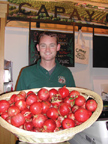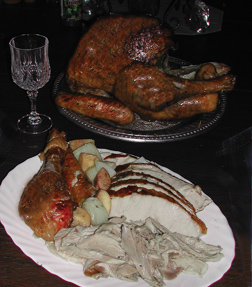This is downright neighborly of us – literally. Capay Organic is the shop just across the way from our Bay Crossings Ferry Building store and we can personally testify that the offerings are scrumptious. Senior Editor Mary Swift cajoled the proprietor into sharing his secret recipe for pomegranates

Published: December, 2003
When bright red bows appear on lamp posts it is like a checkered flag to many to shop for those on their Holiday list. Its Pomegranates that are a cooks signal to get excited that the "Holidays are here". Fresh Pomegranates can be used on so many meats that the possibilities seem endless. What the glaze does is add a unique semi-sweet flavor. Combining sugar with pomegranates can form a moisture barrier while cooking or can be used as with a little vinegar or walnuts for a sauce that brings out truly unique and complementary flavors to any meat.
Capay Farms of the Ferry Market Plaza has a brimming basket of fresh Pomegranates that are ripe and ready to help you create memorable meals for friends and family. Thaddeus Barsotti who is proudly holding the display basket, owns Capay Farms with his 3 brothers. The family started the Farm in 1976. The brothers four began full management in 2000. The Ferry Building is their first storefront. They continue to participate in Farmers Markets in Davis, 3 in Marin county plus Berkeley and Walnut Creek. The brothers also provide "Farm Fresh to You" organic produce delivery service. They can be reached at (415) 391-2223 at the Ferry Building or www.farmfreshtoyou.com.
Pomegranate Glaze and Gravy for the Holidays is shown here with Turkey, but the principals are the same if cooking a leg of lamb, ham, roast chicken or a pork loin. The ingredients are so simple that it is easy to make a truly special meal. What makes the gravy savory and delicious is also very simple. Simply use the juice from the roasting pan to combine with remaining glaze. The pomegranate glaze flavor on the meat is intensified and complimented by the gravy.
While the meat is in a hot oven, searing in the juice, after the side dishes are prepared to go into the oven, bring out a juicer. Hand or electric juicers both work just fine. (If no juicer, peel the pomegranate. Separate the seeds. Put the seeds into a strainer and with the back of a spoon crush the seeds to release the juice.) The goal is 1-1/2 cup of glaze or more for Turkey. The capay pomegranates, with an electric juicer, produced better than a 1/3 cup juice per fruit. Unsweetened Pomegranate juice can be found bottled in Mediterranean Markets but fresh is best when available.
Slowly heat the mixture on medium heat until the butter melts. Stir frequently. It is cloudy at first. The glaze is ready when the butter and sugar fully clarify. The glaze turns a deep clear red. Immediately reduce heat to low. It can scorch once clarified because of the quantity of sugar so keep warm at the lowest setting. Using a turkey baster, baste the turkey during the last 1/4 of the total cooking time. The Holiday Pomegranate glaze mixes the unique flavors of the pomegranate with the herbs and meat juice that collect in the bottom of the roasting pan.
When the turkey is done, remove it to a platter to ‘rest’ tented. While the meat is resting, stir to loosen drippings on the bottom of the pan to get all the herbs and intensely flavored drippings mixed into the juice. Pour the juice and drippings into a separator, or pour into a tall somewhat narrow container and spoon off the fat when it separates. Transfer the juice and drippings to the glaze pot using the remaining glaze as a base. Add the small amount of wine to deglaze and stir. Bring to a slow boil at medium heat and stir frequently allowing to reduce until all the other steps are made to finish the meal.
While someone is carving the Turkey, or just before you do, finish the gravy. Using a cup with a round bottom, spoon in a small amount of the warm liquid. Add the cornstarch. With the back of the spoon mash any hard beads and stir till smooth. Add more liquid until moving freely. Add into the gravy, (this technique works with flour or any other thickener of choice) and stir frequently for 5 minutes until it reaches desired thickness. If it becomes too thick, add wine or water. Delicious poured over the meat, or starch dishes.
Turkey was chosen to use with the glaze for our readers because it such a festive meal. Turkey to some is a real challenge and others have deferred eating turkey other than for Thanksgiving because too often the beast meat becomes dry easily and yet the dark meat ends up too rare. To meet this challenge there are coocking techniques plus and our pomegranate glaze can help.
Gently mash the herbs to release the flavors. Mix the herbs with the stick of unsalted butter to form an herb rub. After rinsing and drying with paper towels. Apply spice and butter rub first under the skin, in the cavity and finally on the skin.
Turning the breast down for the 3/4 of the duration of cooking can imprint unsightly lines in the breast meat. A compromise is to begin cooking in a very hot oven which sears the outside keeping the juices in the meat. This works for most meat, fish or poultry. For turkey, putting water into the pan uses steam to help cook the dark meat faster and to not let drippings burn. To trap steam, prevent burn and spot marks on the turkey breast, cap it with an aluminum tent.
Start the turkey in the 450 degree oven for the first 1/2 of the cooking time with the water and wine in the bottom of the pan, Turn the oven down to 325 degrees. In the last hour of cooking time, partly remove the tent and every 10-15 minutes, baste the turkey with the pomegranate glaze. When the turkey registers 165 degrees at the deepest part of the breast meat, not touching bone, it is done. Remove from the oven, transfer it to a platter, cover with the tin foil tent and let it rest for 20 minutes before carving.
Side suggestions can be seen on the website,
www.baycrossings.com.
Happy Holidays for all of us at Bay Crossings.


